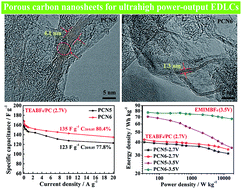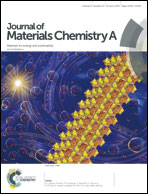2D porous carbon nanosheets constructed using few-layer graphene sheets by a “medium-up” strategy for ultrahigh power-output EDLCs†
Abstract
2D porous carbon nanosheets (PCNs) occupy the foreground in the field of electric double-layer capacitors (EDLCs). However, the mass production of PCNs with ultrathin thicknesses is still a serious challenge. Herein, PCNs constructed of few-layer graphene sheets were synthesized from a sulfonated pitch (SP) carbon precursor and soft-template F127 by a “medium-up” strategy. SP serves as a “medium material”, while F127 acts as a “string” and “spacer”, which plays the leading role of structure directing and prevents the self-restacking of small graphene layers. After activation, sample PCN6 with high carbon yield is constructed with a thickness of only 1.3 nm, sufficient specific surface area of 3006 m2 g−1 and high e-conductivity of 135 S m−1. By virtue of its unique architecture, the PCN6-based EDLC exhibits excellent energy storage properties. In EMIMBF4 electrolyte, it demonstrates an ultrahigh Cg of 157.8 F g−1 (57.4 F cm−3) at 20 A g−1, possessing a top-level rate capacity C20/0.05 of 86.7%. Simultaneously, its energy density can retain up to 67.1 W h kg−1 at a high power density of 17.5 kW kg−1. The ingenious structural design of PCNs can afford inspiration for constructing other 2D architecture carbon materials.



 Please wait while we load your content...
Please wait while we load your content...